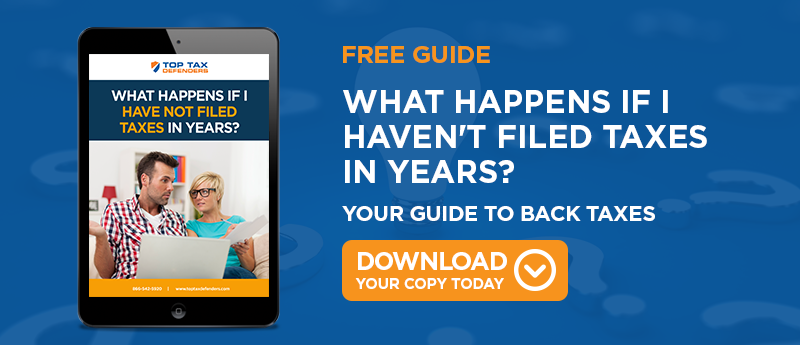
Nothing sets the nerves on edge quite like the need to file back tax returns. Deserved or not, the IRS has a reputation for making life difficult. (We will admit they are trying to be nicer.)
Hiding your head in the sand only makes things worse. If you don’t take care of the situation, the IRS will. The agency can file for you, place penalties on your actions, and charge interest on the money you owe.
When you do file, those late returns receive additional scrutiny from the IRS. Not fun.
Regardless of why you missed the deadline in the first place, the best thing to do is set to work immediately on rectifying the situation. Here is all you need to know about filing back tax returns.
Everybody Files
Almost every taxpayer is required to file a tax return each year. Those who are not required to file are very much in the minority. The IRS keeps records on everyone who files and those who should but don’t.
The IRS pursues missing returns, making life complicated for those who skipped the annual Tax Day.
What Are Back Taxes?
Back taxes are any outstanding federal or state tax liability from a prior year. The IRS is most interested in those who owe the government money. They care only slightly less for those who are due a refund.
The process for filing back tax returns is similar to on-time returns. You need all the documents from the tax year in question. Anything you are missing, you can request from your employer, financial institution, and other entities. It’s a good idea to request a tax return transcript from the IRS to make sure you don’t miss anything.
Most importantly, make sure you use the correct tax form for the year you are filing. Tax law and legislation changes all the time. You need to follow the rules for the particular year for which you are filing.
Why Should You File a Back Tax Return?
Aside from taking the IRS spotlight off yourself, you should file a back tax return if you want to receive a refund due.
If you owe taxes, filing a return sets the stage to ending penalties and interest accruing on the amount due.
If you apply for a mortgage or other loan, or if you submit paperwork for federal financial aid, you need to provide a copy of your tax return as part of the documentation. You also need to pay your Social Security taxes to qualify for benefits.
How Long Can You Wait?
The IRS accepts back tax returns for as far back as you care to make them. They prefer it, in fact. However, the IRS typically only requires the past six years of back tax returns to be filed to be considered in good standing.
There are exceptions to the rule, however. The IRS can still choose to go back farther than six years in specific circumstances.
If you are filing to claim a refund or tax credit, you only have three years. After that, you can file, but you won’t get anything except a late filing penalty.
How to File a Late Return
Step 1: Gather Information
Put together a file of all the documentation you need to file taxes for the specific year:
- W-2s
- 1099s
- Bank statements
- Loan statements
- Documentation for tax credit opportunities
File for additional time if you need it. By doing so, you may avoid enforcement actions like a tax lien against your property, a tax levy, or a substitute return created by the IRS.
Step 2: Request Tax Documents from the IRS
To make sure you don’t miss anything, request wage and income transcripts as well as an account transcript for any estimated tax payments or other credits posted to your account for the year. Use Form 4506-T to request your account transcript.
Unfortunately, the transcript won’t say anything about deductions and credits you might qualify for. You will have to dig that up yourself.
Be aware; it can take the IRS up to 45 days to process your Form 4506-T. That’s 45 more days of interest accruing to your account while you wait.
Step 3: Identify Special Processing
Does anything need to be date-stamped? Do you need to file with an IRS compliance unit?
Step 4: Complete and File Returns
Once you have all the documentation you need, file those returns as soon as possible.
- Check each return for accuracy.
- Attach a penalty relief request if applicable.
- Send it to the correct IRS location.
- Obtain proof of filing in case the IRS doesn’t process the return, or you are hit with compliance activity like collection notices, liens, levies, or an unfiled return investigation.
Please note: you cannot e-file your back tax returns. You need to use good old postal mail to file and make your payment.
Step 5: Monitor the Progress of Your Return(s)
Keep watch for compliance activity so that you can address it immediately. Also, keep an eye on your returns to make sure they are being processed as expected.
Paying Back Taxes
Now to turn your attention to the other reason for filing back taxes — paying them.
Ever since you did NOT file, the amount you owe increased due to penalties and interest. If you cannot pay the entire amount all at once, you have some options.
- Set up an installment payment plan with the IRS.
- Apply for an Offer in Compromise.
- Request a delay on collections.
- Apply for reasonable-cause assistance.
- Apply for penalty abatement relief.
Until you pay your balance in full, interest continues to accrue to your account. So, the faster you pay it off, the better off you are.
What If You Don’t Pay?
Not paying taxes is serious business, and it has consequences beyond your dealings with the IRS. The IRS will charge a penalty for not filing and one for non-payment. If you underpaid estimated taxes, you could get a penalty for that, too. Obviously, you won’t receive any refund.
Outside of the problems with the IRS, not filing your taxes can keep you from obtaining a mortgage (at least, at a reasonable interest rate), federal financial aid, or other loans. Also, you won’t receive credits toward your Social Security benefits for self-employment income.
Get Some Help
You don’t have to do all this alone. Make an appointment with tax professionals like Top Tax Defenders.
Bring all of your documentation, including copies of your notices, especially the most recent ones for years you didn’t file. Bring along all your tax documentation like your W-2s and 1099s for each year you need to file taxes.
If you have a statement for state withholding or estimated tax payments made, bring those along, too. Include all the information needed to complete each return.
If you have a levy in place, provide your employer’s or financial institution’s contact information along with a copy of any tax returns filed the year before and after the years you didn’t file.
Not filing your taxes isn’t the end of the world, but it can cause you plenty of trouble and expense. You can fix it by filing your back taxes as soon as possible. Get your tax debt paid off, so the IRS stops charging interest.
And from now on, try not to skip Tax Day. You have been warned.




